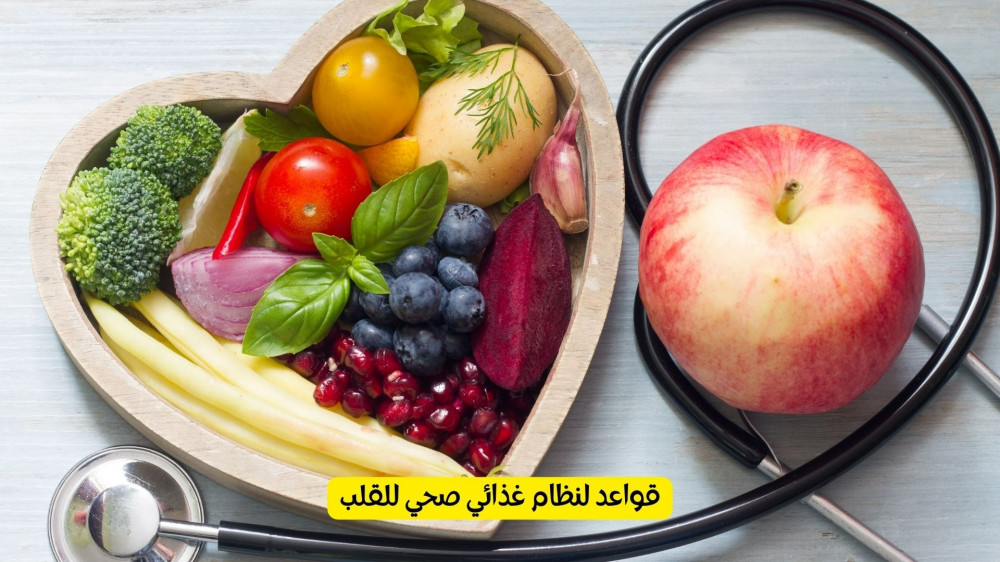Rules for a heart-healthy diet
Diet can make a big difference in achieving the goal of maintaining heart health, and there are several methods that you can follow to maintain it for a longer period and delay injuries resulting from wrong habits or diseases resulting from aging, such as atherosclerosis, blood pressure, and cholesterol..
1- Maintaining a healthy weight throughout life:
This means balancing food and calorie intake with physical activity. The researchers advised following a healthy diet that includes portion control along with at least 150 minutes of moderate physical activity per week. People should eat less as they age because daily energy needs decrease by up to 100 calories with each decade.
2- Include vegetables in all meals and eat fruits with low sugar content:
Researchers have indicated that diets rich in fruits and vegetables, in all their forms, whether fresh or frozen, are associated with a lower risk of heart disease. They recommended choosing deep-colored products, such as leafy vegetables such as cabbage, lettuce, spinach, parsley, and molokhiya.
To get more nutrients. It is also better to eat whole fruits rather than juice them, because the whole form contains more fiber and makes a person feel full. Taking into account choosing fruits with low sugar content, such as strawberries, raspberries, oranges, grapefruit, and avocados, it is better to obtain a full range of nutrients from food rather than from supplements.
3- Choose whole grains:
Studies have shown that eating whole grains such as whole grains, oats, oatmeal and brown rice instead of refined grains such as white rice improves cardiovascular risk factors. Products made with at least 51% whole grains are usually labeled as whole grains.
4- Use unsaturated fats instead of saturated and hydrogenated fats:
This means olive, sunflower, and soybean oils.
In addition to the fats found in walnuts and flax seeds. Avoid coconut oil, butter and partially hydrogenated fats.
Among the benefits of unsaturated fats:
Consumption of trans fats is associated with a large number of health benefits, including the following:
Support heart health.
Reducing the risk of premature death and cardiovascular disease.
Fighting inflammation, which may help prevent many chronic diseases, such as: arthritis, diabetes, or any autoimmune disease accompanied by inflammation.
Enhancing the absorption of certain vitamins, such as: vitamin A, vitamin D, vitamin E, and vitamin K.

5- Healthy sources of protein:
There are two types of protein:
· First, plant protein:
Such as legumes and nuts, which are also good sources of fiber.
Legumes include soybeans, tofu), lentils, chickpeas, and peas.
Many scientific studies have also shown the role of whole grains in reducing the risk of cardiovascular disease, and this may be due to their containment of soluble fiber, which, secondly, animal protein:
It is also recommended to regularly eat fish and seafood at least two servings per week due to their omega-3 fatty acid content, although fried fish does not provide the same heart-health benefits as grilled or steamed fish.
It is best to replace full-fat dairy products with semi-fat options to reduce consumption of saturated fats and lactose, which is the type of sugar in milk.
If you still want to eat meat and poultry, stick to lean meats. Limit red meat and processed meats such as sausage, hot dogs and salami to reduce salt, saturated fat and cholesterol.
6- Choose low-processed foods:
Choose foods that do not contain added salt, sugar, fat, artificial colors, flavors or preservatives.
Examples of unprocessed foods include fruits, vegetables, and legumes, which are considered unprocessed or minimally processed foods.
Fast food, snacks such as chips and biscuits, and prepared meats are examples of highly processed foods.
7- Limit sugary drinks and foods:
Added sugars have been associated with glucose, dextrose, sucrose, corn syrup, honey, and concentrated fruit juice.
These foods or drinks increase the risk of type 2 diabetes, heart disease, and excess weight.
The researchers pointed out that drinks containing low-calorie sweeteners may not be better alternatives because there are “mixed results” about their effect on body weight and metabolic results. Therefore, caution must be taken from these drinks and replaced with drinks sweetened with calorie-free artificial sugar. Aspartame is like stevia and sucralose.
8- Choose foods that contain little or no salt:
There are studies that confirm a “direct relationship” between salt intake and blood pressure. Eating less salt lowers blood pressure, and this effect is greater in middle-aged people, the elderly, and those with high blood pressure. Studies have shown that processed foods, meals prepared outside the home, packaged foods, and restaurant foods represent nearly three-quarters of total dietary sodium.
But remember: Even foods labeled 100% whole wheat or organic can be high in salt.
9- Limit alcohol consumption:
Studies indicate that there is a complex relationship between drinking alcohol and heart disease.
Although low alcohol intake is associated with a lower risk of coronary heart disease and stroke, the American Heart Association does not support starting drinking at any level, "given uncertainty about net health effects."
You can certainly adapt a heart-healthy diet to different lifestyles, including the diet to stop eating in restaurants. It may take a little planning, but after the first few times it can become routine.
References:

